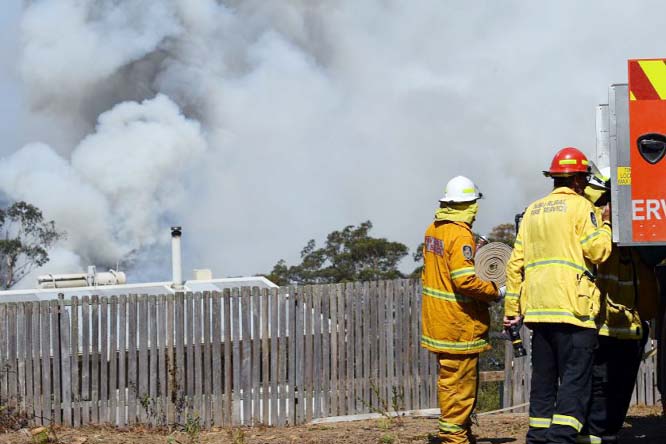
AP, Eden, Australia :
Thousands of people fled their homes and helicopters dropped supplies to towns at risk of nearby wildfires as hot, windy conditions Friday threatened already fire-ravaged southeastern Australian communities.
The danger is centered on New South Wales and Victoria, Australia’s most populous states, where temperatures and wind speeds are escalating after a few days of relatively benign conditions.
The New South Wales Rural Fire Service had warned that coastal towns south of Sydney including Eden, Batemans Bay and Nowra could again be under threat weeks after losing homes to the fires. By early evening Friday, the wildfires burning in that region were holding within containment lines, but a strong shift in winds predicted for later Friday could cause them to flare anew, Rural Fire Service Commissioner Shane Fitzsimmons told reporters.
“A long afternoon to go, a long night still to go, for all our firefighters and those affected by the fires,” Fitzimmons said.
In neighboring Victoria, evacuation orders were issued in alpine areas, and Premier Daniel Andrews pleaded with residents to heed alerts and avoid complacency even though no fresh destruction was being reported.
“Despite this unprecedented fire activity, we have nobody who is unaccounted for, we have no further people who have died, and we have no further communities who have been cut off,” Andrews told reporters. “Now, all of those things can change and that is perhaps the most powerful reminder that we have to remain vigilant. Please, listen to the warnings and do as you are asked. If you are told to leave a community, and you can leave, then you should leave.”
The unprecedented fire crisis in southeast Australia has claimed at least 26 lives, destroyed more than 2,000 homes and scorched an area twice the size of the U.S. state of Maryland since September.
Prime Minister Scott Morrison said the Australian military was on standby to help firefighters and emergency agencies. “I’ve given them very clear instructions that they are to stand ready to move and support immediately,” Morrison said on Friday. “In the event that they are needed in the wake of what we hope we will not see today, but we must prepare for today.”
The military has already been involved in the unfolding crisis by clearing roads closed by fallen trees, burying dead cattle and sheep and providing fodder to surviving livestock. Fire crews throughout the region were bracing for a long, rocky night. In the southeastern New South Wales town of Candelo, Nathan Barnden, a divisional commander with the Rural Fire Service, was preparing to head to the nearby township of Burragate with his team to protect the community from a fire that was marching north from the Victoria border. The fire had breached containment lines in one area, and officials were worried that predicted winds of 60 to 100 kilometers per hour (40 to 60 miles per hour) could push it into populated areas.
Thousands of people fled their homes and helicopters dropped supplies to towns at risk of nearby wildfires as hot, windy conditions Friday threatened already fire-ravaged southeastern Australian communities.
The danger is centered on New South Wales and Victoria, Australia’s most populous states, where temperatures and wind speeds are escalating after a few days of relatively benign conditions.
The New South Wales Rural Fire Service had warned that coastal towns south of Sydney including Eden, Batemans Bay and Nowra could again be under threat weeks after losing homes to the fires. By early evening Friday, the wildfires burning in that region were holding within containment lines, but a strong shift in winds predicted for later Friday could cause them to flare anew, Rural Fire Service Commissioner Shane Fitzsimmons told reporters.
“A long afternoon to go, a long night still to go, for all our firefighters and those affected by the fires,” Fitzimmons said.
In neighboring Victoria, evacuation orders were issued in alpine areas, and Premier Daniel Andrews pleaded with residents to heed alerts and avoid complacency even though no fresh destruction was being reported.
“Despite this unprecedented fire activity, we have nobody who is unaccounted for, we have no further people who have died, and we have no further communities who have been cut off,” Andrews told reporters. “Now, all of those things can change and that is perhaps the most powerful reminder that we have to remain vigilant. Please, listen to the warnings and do as you are asked. If you are told to leave a community, and you can leave, then you should leave.”
The unprecedented fire crisis in southeast Australia has claimed at least 26 lives, destroyed more than 2,000 homes and scorched an area twice the size of the U.S. state of Maryland since September.
Prime Minister Scott Morrison said the Australian military was on standby to help firefighters and emergency agencies. “I’ve given them very clear instructions that they are to stand ready to move and support immediately,” Morrison said on Friday. “In the event that they are needed in the wake of what we hope we will not see today, but we must prepare for today.”
The military has already been involved in the unfolding crisis by clearing roads closed by fallen trees, burying dead cattle and sheep and providing fodder to surviving livestock. Fire crews throughout the region were bracing for a long, rocky night. In the southeastern New South Wales town of Candelo, Nathan Barnden, a divisional commander with the Rural Fire Service, was preparing to head to the nearby township of Burragate with his team to protect the community from a fire that was marching north from the Victoria border. The fire had breached containment lines in one area, and officials were worried that predicted winds of 60 to 100 kilometers per hour (40 to 60 miles per hour) could push it into populated areas.

